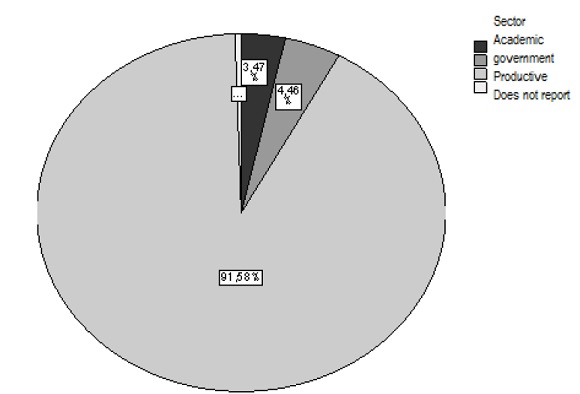
Figure Nº 1. Classification of members registered in CABASE according to their belonging to the academic, government or productive environment
Source: Own elaboration
Value creation from the Internet of things: Exploratory study in Buenos Aires Province
(*) Marisa Analia Sánchez; (**) Gustavo Ramoscelli
(*)National University of the South,
Bahía Blanca, Buenos Aires,
Argentina
mas@uns.edu.ar
(**) National University of the South,
Bahía Blanca, Buenos Aires,
Argentina
ramoscel@uns.edu.ar
Reception Date: 12/12/2017 - Approval Date: 12/27/2017
ABSTRACT
The development of value propositions based on the Internet of Things (IoT) requires knowledge and experience in technology. For non-technological organizations it is difficult to independently provide a complete solution based on IoT. The aim of the work is to carry out a survey on the situation and the development of the IoT product and service suppliers, the scientific production and the government initiatives. The research methodology is based on literature reviews, analysis of academic publications and opinion poll in order to define the situation in the productive and academic sectors. As a result an incremental evolution of the sector is observed. The productive sector is organized in chambers that offer trainings and events directly related to the development of IoT solutions. The academic sector denotes a scientific production in indexed journals and made in collaboration with institutions of other countries. The Government area is one of the most advanced given that there are numerous applications developed by municipalities in the context of intelligent cities.
Key words: Internet of Things; Digital Transformation; Collaboration; Product-as-a-service model.
INTRODUCTION
Organizations are undergoing a transformation as a consequence of digital technologies. The analysis of large volumes of data affects business processes and the way decisions are made; social networks reflect the actions, interactions and consumption of customers; mobile applications and cloud computing are essential to provide services; the Internet of Things (T) links products through sensors creating new possibilities to create value or reduce costs; Robots, drones and 3D printing are key drivers in the evolution of supply chains. For Latin America, an increase of 21% in Internet traffic is estimated; 6.7% in Internet users; 8% in device connections (CAGR from 2015 to 2020) (CISCO, 2016). In particular, the development of value propositions based on the Internet of Things is mobilizing the sector of manufacturers and developers of chips, sensors, software and the technologies used to transmit data to and from connected devices. Until recently, the concept of the T was only known in technical areas, but the growing number of projects linked to smart cities (smart parking, waste collection, traffic management), to agriculture (Alvarez, Serafino, Ciceerchia, Russo, Ramón, and Lorea, 2017), the transport sector, health, among others, has disseminated these solutions, and above all the opportunity to create new business models that change the focus on independent products to offers based on services. The development of value proposals based on the T demands knowledge and experience in technology. For non-technological organizations it is difficult to provide a complete solution based on the (T) independently. It is recommended to build an allied ecosystem and co-develop with them (Kranz, 2017). Due to the (T), the industry is rapidly evolving into a world of alliance and co-creation ecosystems with customers. It is a complex and strategic transition for both sellers and users of technology-based solutions and these results are an open ecosystem of standards-based (T) solution providers (Kranz, 2017). Weill and Woerner (2015) point out that organizations not only fail to take the opportunities provided by digitization, but that they fail to adapt their business models to reflect the economic characteristics and underlying mechanisms of digitization. In other words, taking advantage of opportunities requires a leadership that understands the opportunities and the necessary resources and capacities.
Then, it is interesting to know the regional capacities to respond to the digital transformation. To make a complete diagnosis it is necessary to analyze several factors. The objective of this work is to study only aspects specific to (T)-based developments, and the research question and the development of solutions based on the (T) in the province of Buenos Aires and the Federal Capital is proposed as a research question. Although the study focuses on this region, the conclusions are relevant for the country given that the region concentrates the main entities in both the public and private spheres. In the Autonomous City of Buenos Aires, approximately 70% of the software generating companies are installed, which export more than 340 million dollars nationwide (Capellán, 2016). It should be noted that there are no publications that respond to the objective set out in this work. Therefore, the research contributes with an analysis that considers the productive, academic and governmental sectors.
In order to address these questions, an exploratory methodology is used. The main chambers of organizations that carry out activities related to the (T) are analyzed for the private sector and a survey is made to estimate the number of companies related to the sector and determine what type of solutions they offer. For the academic sector, a description of the scientific publications related to the topic and the main related scientific events is made. Also, secondary sources are analyzed to determine the governmental initiatives.
The work is organized according to the detail that is exposed here. Section 2 details the work methodology. The following section provides a conceptual framework on the impact of digital transformation on organizations and in particular on the (T). Then, sections 4, 5 and 6 describe the results of the survey for the private, academic and governmental sectors. Finally, in section 7 the conclusions are synthesized.
DEVELOPMENT
Methodology
In order to address these questions, an exploratory methodology is used. This type of research is done when the subject has been little explored. First, a literature survey is carried out to describe the impact of IoT on organizations, the expected benefits and challenges highlighted by other authors. To carry out a survey in the different sectors, information published on websites by cameras, companies and municipalities is analyzed, and in addition, an opinion poll is made to members of a chamber. In this way, it is possible to determine which are the main chambers that group organizations that develop activities linked to the IoT and estimate the number of companies related to the sector and establish what type of solutions they offer. For the academic sector, a description of the scientific publications related to the subject is made. They are considered works in indexed journals and with at least one author whose affiliation corresponds to an academic institution of the Argentine Republic. Finally, the characteristics of the main related scientific events are described from the information published on the Internet.
Conceptual framework
Loebbecke and Picot (2015) use the term digitalization to refer to changes in established patterns caused by digital transformation and innovations in the economy and in society. Digitization penetrates all areas of life and creates new forms of work, communication and cooperation. Shirky (quoted in (Loebbecke and Picot, 2015)) mentions that the connection of individuals, companies, devices and government facilitates the realization of transactions, collaboration and social interactions and results in huge data sources. Interaction between objects adds a multitude of data sources. More connections are required with a wide spectrum of organizations and this depends on an adequate management of new relationships with interest groups such as customers, suppliers and rivals. New companies such as Uber or Airbnb surprise with their ability to define successful business models based on innovative uses of technology. Even traditional companies in their sector such as Nike (Fox, 2017), GE (General Electric, 2017), Siemens (The Economist, 2016) are being transformed to offer services (not products) based on new technologies. Ford Motor Company has 40 assembly plants of which 25 use (T) technology to accelerate communications between them. The state-of-the-art automated vehicle planning system manages production in real time, handling more than 2 million variations (Kranz, 2017). Moreover, Ford announced a subsidiary to expand the scope of its business beyond automobiles to smart mobility (Newcomb, 2016).
What is the impact of (T) on organizations?
The term Internet of Things was introduced by Kevin Ashton in 1999 (Ashton, 2009). Ashton visualizes that a physical world can be connected via the Internet with sensors capable of providing information in real time and thus benefit our lives. Over time, this notion has been considerably expanded (Olson, Nolin, and Nelhans, 2015). Gubbi et al. (2013) define (T) as the interconnection of sensors and controllers that provide the ability to share information through platforms, developing a common operating framework to enable innovative applications. Similarly, Cao et al. (2016) define the (T) as a highly interconnected network of heterogeneous entities such as tags, sensors, embedded devices, handheld devices, and servers, which provide new services and applications. A concept closely linked to the (T) is that of machine-to-machine communication systems (M2M). The (T) focuses on endpoints and the interconnection of physical objects with each other and with humans, while machine-to-machine (M2M) systems refer to automatic systems that involve devices that automatically collect data from a remote source, they exchange information, and act on the environment according to control messages, without human intervention (or very limited) (Cao, Jiang, and Han, 2016). In this way, M2M systems play a very important role in the realization of the (T).
The use of the (T) is transversal to all industrial sectors. Some examples of application domains include home and personal use (smart residential equipment, smart health sensors); companies (intelligent identification and traceability of products for retailers, industrial ecosystems), utilities (household energy meters); transport (smart traffic, autonomous vehicles, and highway logistics).
It is important to highlight the impact of new technologies, and the (T) in particular, in the definition of the value proposition of organizations. The first successful examples of the introduction of (T) devices show that the business model is orders of magnitude more important than technology (Yankelevich, 2017). A business model describes how a company makes money from the value it creates. In the (T), all the incremental value comes from transforming the data into useful knowledge. (T)-enabled products can monitor the customer's usage pattern and satisfaction represents an opportunity for manufacturers to elevate technology to create new business models that shift the focus from individual products to service offerings (Porter and Heppelmann, 2015).
Research on the design of digital organizations emphasizes the importance of developing a digital strategy that takes advantage of digital technologies (Ross, Sebastian, and Beath, 2016). The authors distinguish two types of strategies: a strategy based on attracting clients that aims to create superior and personalized experiences to achieve greater loyalty; and a strategy with the objective of developing products and services enriched with information that provide new value to customers. Finally, the research highlights that operational excellence is a minimum requirement to define digital business models.
As mentioned in the job introduction, no organization can provide a complete (T) solution independently. Yankelevich (2017) highlights that the (T) requires skills from different areas (electrical engineering, programming, embedded systems, physics and communications) and generally involves complex business problems. Kranz (2017) recommends building an allied ecosystem and co-developing with them. The author highlights the following challenges during the creation of value from the (T): it requires the ability to analyze large volumes of data; ability to share data with customers, suppliers and competitors and to manage the flow of data. The analysis of information is central to the (T). The connected and intelligent products, from the registers of their sensors generate a large volume of data in real time and of diverse variety (for example, readings of temperature of a motor, of the fuel consumption, of the humidity of the ground). The analysis of them allows to build a model that can have as objective to diagnose or predict depending on the application. Porter and Heppelmann (2015) describe a new organizational structure that includes a functional unit dedicated to data management. Led by a manager, the unit manages the collection and analysis of data, and shares the information and knowledge throughout the organization. McAfee and Brynjolfsson (2012) describe five management challenges related to data management and refer to leadership, talent management, technology, decision making and culture. Companies need leaders who can recognize a great opportunity, understand how the market develops, think creatively and propose offers of truly innovative value, articulate a compelling vision, persuade people to assimilate and work for it, and relate effectively to all interest groups. Organizations require the ability to help leaders reformulate their challenges in a way that the analysis of large volumes of data allows them to be addressed. It is also necessary to increase cooperation between people who understand the problems and those who master problem solving techniques and can generate value from the data (Davenport, Barth, and Bean, 2012). Most organizations do not have these skills, so alliances with technology experts become an appropriate strategy.
When talking about the (T) it is inevitable to mention the role of platforms. Internet, mobile, cloud computing, and social technologies have reduced the need to own a physical and capital infrastructure, resulting in businesses based on platforms such as Amazon, Uber, Airbnb or eBay. The platforms include four types of actors: the owners of the platform control intellectual property and governance (Google owns Android); the providers serve as an interface between the platform and the users (mobile devices are providers on Android); producers create their offers (applications on Android), and consumers use those offers (Van Alstyne, Parker, and Choudary, 2016). With the advent of (T), the concept extends to "Internet of Things as a platform" to manage device connections and allow users to specify the meaning of interactions. For example, smart cities (Wang, He, Huang, and Zhang, 2014), energy grids (Tanoto and Setiabudi, 2016), factories (Woo, Jung, Euitack, Lee, Kwon, and Kim, 2016) or health (Ishii, Kimino, Aljehani, Ohe, and Inoue, 2016) as platforms. These examples show that the management of relationships between different interest groups is more important than ever.
Next, the situation of the private, academic and public sectors in the context of the province of Buenos Aires and the Federal Capital is described.
Survey in the private sector
In this section we describe the main chambers of organizations related to the development of (T)-based technologies. An internet search is done using the words Argentina, chambers, (T), imbibed, and communicators. From the results, the chambers that publish events, projects or articles related to the (T) are selected. In addition, based on a survey of the companies registered in the chambers, it is determined how many provide solutions based on the (T).
Argentine chambers and networks linked to the (T)
CADIEEL is the Argentine Chamber of Electronic, Electromechanical and Lighting Industries. It is a civil society, non-profit that brings together industrial companies whose activities are developed in the territory of the Argentine Republic and which are related to the production of goods that contain elements or mechanical, electrical or electronic parts; elements or software parts; producers and integrators of hardware or software systems for plants or networks that make use of the previous items as well as the associated services (CADIEEL, 2017).
CABASE (founded in 1989) is the chamber that brings together companies providing Internet access services, data center services, online content and other services related to Internet technology. In 1998, it inaugurated the first Internet access point in Latin America. In 2011, its statute was modified and can be reviewed as adherent partners by individuals or legal entities that do not meet the conditions required to be active partners, wish to be associated with the activity, provide effective and technical assistance to the Chamber (CABASE, 2017). It is made up of ten work commissions, one of which is dedicated to the (T) and aims to help partners face the challenge of discovering new businesses and strategic partners to develop solutions for smart cities, smart homes, among others. Argentina Internet, 2017). On the website of this commission, 13 organizations providing (T)-based technologies or products are listed, of which 11 belong to the productive sector, and the other two belong to the academic field. In addition, it informs about the first event in which more than 60 companies and organizations interested in exploring the possibility of undertaking business based on the (T) jointly participated (Argentine Internet Chamber, 2017).
The Smart Cities Network of Argentina (RECIA) is a space for the exchange of experiences and knowledge to promote smart cities and improve governance. The network is made up of references from smart municipalities throughout the country (almost 50 to September 2017), a Board of Directors and an Advisory Board. The latter brings together individuals from the private sector, the state, academia and civil society. They provide thematic advice to the network on its lines of work (RECIA, 2017). On its website, it publishes information about companies, products and information technology services for public administration. The main activities refer to meetings and trainings.
The Chamber of Computing and Communications of the Argentine Republic (CICOMRA) brings together industrial, commercial and service companies from the IT and communications sector in the country. Founded in 1985, it develops activities that cover the main topics of interest of the sector through the commissions of Information Technology Policy, Communications Policy, Foreign Trade and Technology and Industry. These work commissions are forums for debate and analysis of the evolution of the market, aimed at promoting the application of technology to promote the social and economic well-being of the country (CICOMRA, 2017).
Survey from member companies of CADIEEL
The list of associates published on the CADIEEL website (accessed in July 2017) is considered, and 279 members are registered. For each member, the information published on the website of the chamber and the organization is analyzed to determine whether it provides solutions linked to the (T). Only 29 members publish solutions based on (T) technology: the majority related to the marketing of smart luminaires, smart buildings, agro-industry (measurement of greenhouse gases), health (remote patient monitoring system, automation of procedures of laboratory), the public sector (intelligent traffic lights with extended accessibility, railway track control systems, measurement and mitigation of acoustic emissions), and robotics in manufacturing plants. Among the organizations, it stands out for its size and trajectory Intel. Intel is creating tools that put artificial intelligence and data to work in simpler, easier and almost invisible ways for users in different areas of everyday life, namely: the automotive industry, health, sales, energy, among others. All organizations are located in the Federal Capital or Greater Buenos Aires.
Survey based on registered members in CABASE
From the information published on the CABASE website, it can be seen that for the province of Buenos Aires, 202 associates are registered, including companies, government agencies and national universities. From the public information of each partner (information on the websites) it was classified according to membership in the academic, governmental or productive sphere. In addition, associates are classified considering economic activity. The classification is made according to the International Standard Industrial Classification of all economic activities (ISIC) (United Nations, 2009). It constitutes the international classification of productive activities and provides four levels of classification (sections, divisions, groups and classes). Only one case was not possible to classify since the information was not enough. Most of them offer Internet access services and were included in the Other telecommunications activities class. In general, it is not observed that companies offer services linked to the (T). Eight cases were observed that make direct reference to the (T), to intelligent products (for example, one company offers (T)-based solutions for mobile commerce, logistics, smart cities and intelligent monitoring, other intelligent software services for fleet control and logistics dispatch) or have participated in some project. Figure No. 1 and Table 1 summarize the results.

Figure Nº 1. Classification of members registered in CABASE according to their belonging to the academic, government or productive environment
Source: Own elaboration
Table Nº 1. Clasification of the CABASE members according to the economy activity using the Uniform International Industrial clasification of all economy activities (CIIU) (United Nations, 2009)
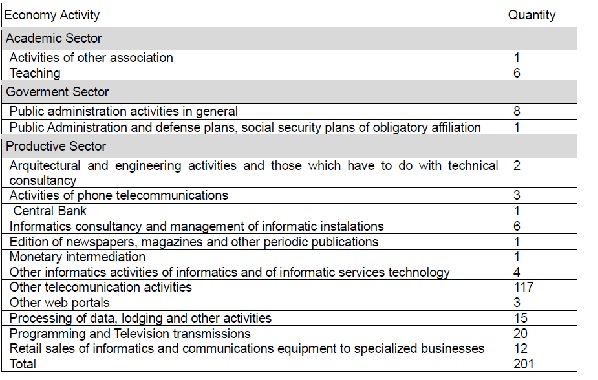
Source: Own elaboration based on information published on the Internet by organizations
Survey in the academic sector
To explore the scope of the research on topics related to the (T), information is presented based on scientific publications on the subject and related events held in the region under study.
Analysis of scientific publications
To analyze scientific works, publications indexed in the Scopus bibliographic database are compiled. Works that contain the search string Internet of Things or (T) are retrieved in their title, summary or keywords. The period from 2006 to September 12, 2017 was considered. 26,554 works are collected, of which 22.13% and 13.12% correspond to China and the United States, each. Figure No. 2 shows the number of publications by country and to contextualize the situation of Argentina with respect to the region, only Latin American countries are included. Latin America contributes 2.5% of publications.
Next, the works corresponding to the Argentine Republic are characterized. Three papers are excluded because they correspond to a medical theme without linkage with (T), leaving 20 publications for the analysis. A positive trend is observed in the number of publications (the year 2017 is not finalized at the time of the survey).
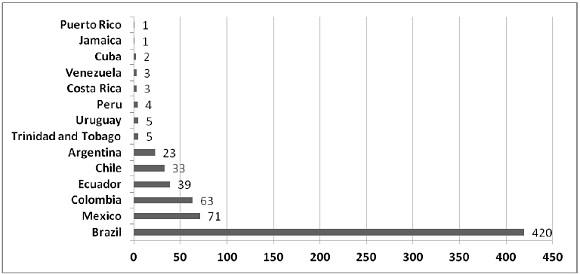
Figure No. 2. Number of publications by country that contain the text Internet of things or (T) in its title, summary and / or keywords (only countries in Latin America are included)
Source: Own elaboration based on data from Scopus
Another aspect included in the analysis of the data refers to the type of publications. 80% (16 articles) correspond to works published in conference proceedings. From the thematic areas classified by Scopus, it is observed that Computer Science and Engineering predominate (see Figure N ° 3).
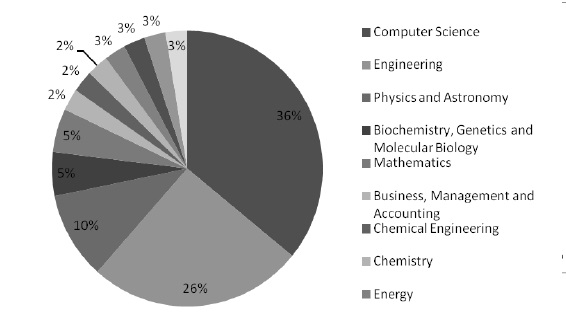
Figure Nº 3. Publications of authors with affiliation in the Argentine Republic by thematic area. The thematic denominations (in English) provided by Scopus are included
Source: Own elaboration based on data from Scopus
If the affiliations of the authors and co-authors are analyzed, the National Technological University appears as the institution with the greatest number of contributions (9). Several works are carried out in co-authorship with researchers with an affiliation outside the Argentine Republic (see Figure N ° 4).

Figure Nº 4. Affiliations of the authors and co-authors (of the 20 publications with an author from the Argentine Republic)
Source: Own elaboration based on data from Scopus
Scopus is used to retrieve the citations of the 20 articles. 105 works published during the period 2013-2018 that quote 9 of the 20 works are recovered. The largest number of citations occur in 2015 (26). The most cited work corresponds to Juan Pablo Conti (Conti, 2006) with 68 citations, of which 37 are from authors with affiliation in China.
Events related to the (T)
In the Argentine Republic, several events are held annually that bring together both the academic and industrial community. The Argentine Symposium on Embedded Systems (SASE) disseminates the technologies associated with embedded systems in the professional and academic field and highlights the areas of programming, manufacturing and certification thereof, bioengineering, information security, (T), robotics and intelligence. Artificial, real-time operating systems, among others. It has been carried out since 2010. In 2016, more than 1,100 people participated, of which 93% came from Argentina, while the remaining 7% was distributed among Mexico, Uruguay, Paraguay, Peru, Colombia and Chile (SASE, 2017).
The Argentine Conference on Information Technology (JAIIO) is organized by the Argentine Information Society (SADIO, 2017) and includes symposia in which applications based on the (T) and some basic research developments on (T) are presented, namely: the Agro Congress -Computer, Symposium of Industrial Computing, the Workshop of the Working Group of Internet Engineering, the Argentine Congress of Informatics and Health, among others.
In October of 2017, an (T) Update Conference was held in Buenos Aires organized by the Argentine Chapter of the IEEE Communications Society with the objective of promoting public-private interaction for the development of an (T) market ecosystem. In the event, topics on avant-garde (T) architectures, use cases for vertical markets, the Argentine regulatory framework, among other topics were presented.
Results from opinion poll to SASE members
The data source corresponds to a survey carried out through an on-line survey system that was enabled between August 25 and September 15, 2017 (the questions are included in the Annex). SASE has a forum in which the authors had access to request the opinion of the members. The survey was answered by 12 members and does not intend to form a representative sample but allows to present an opinion poll. Organizations from the technology, software, agribusiness, aerospace and education sectors participated. Figures N ° 5 and 6 present the profile of age and size of the organizations to which the respondents belong. In the answers, eleven indicate that they are working or plan to do it in 12 months in projects that include (T) technology (the responses of these eleven are processed).
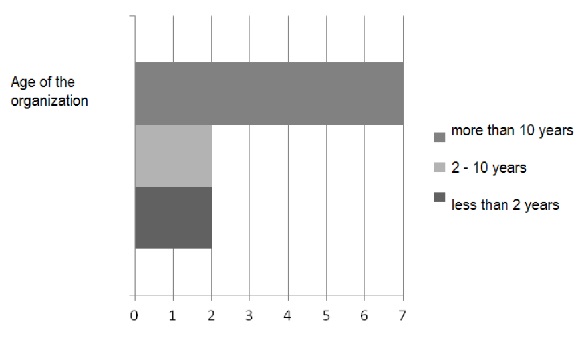
Figure Nº 5. Antiquity of the organizations belonging to those who answered the opinion sounding
Source: Own elaboration as from the opinion sounding of SASE members
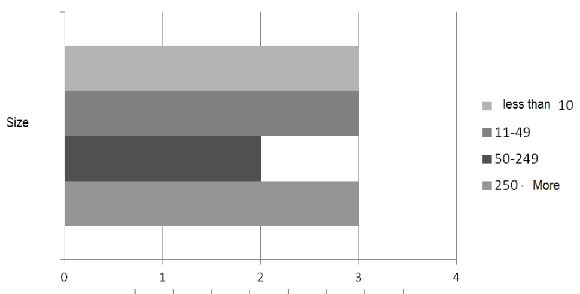
Figure Nº 6. Affiliations of the authors and co-authors (of the 20 publications with Figure Nº 6. Size of the organizations (in number of employees) to which they belong who answered the opinion poll
Source: Own elaboration based on the opinion poll of SASE members
Seven of those who responded to the survey have their own work teams while the rest plan to create mixed teams of internal staff and service providers. Commercial reasons are highlighted among the main motivations linked to the (T)-based initiatives, and the efficiency of the processes is improved.
Table No. 2. Results of the question What are the motivations for (T) initiatives? (multiple choice)
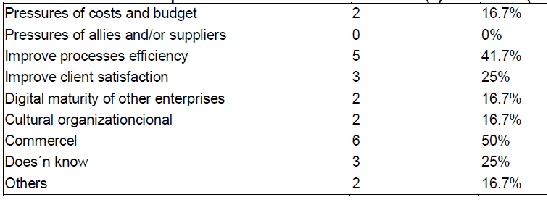
Source: Own elaboration based on the opinion poll of SASE members
The respondents point out that the benefits that are expected to be obtained include the development of new products or services, more efficient ways of providing services to clients and the ability to develop new businesses. These results reflect the knowledge of (T) opportunities and an interest in improving the offer to customers.
Table Nº 3. Results of the question What benefits do you expect from a solution based on (T)? (multiple choice)

Source: Own elaborations from the opinion of SASE members
There are numerous barriers that impede or limit the development of (T)-based solutions: lack of collaborative culture, concerns for safety, lack of leadership, lack of a suitable provider with which to work, unclear benefits, among others. No respondent indicated that the (T) was not part of the organization's strategy, however, all barriers suggested in the list were selected. If it is considered that most of the members indicated belonging to an organization more than 10 years old, the barriers selected suggest that there is still perceived lack of experience and consolidation of these developments.
Table Nº 4. Results of the question What barriers prevent your organization from adopting or developing (T)-based solutions? (multiple choice)
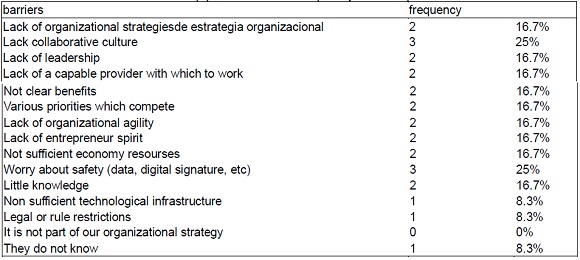
Source: Own elaborations from opinion of SASE members
Survey in the public sector
Government organizations around the world are making efforts to adopt digital technologies, mostly mobile and applications, as new ways to provide services (World Bank, 2017). On the other hand, the extension of the use of information to govern is characterized by a wide disparity among developing countries in the world (Dahiya and Mathew, 2017). Argentina has received a relatively good rating based on the development rate of electronic government. The country is in position 41 according to the mentioned index (it considers the online service, the development of electronic government, online participation, telecommunications infrastructure and its components, and human capital) (United Nations, 2016). The purpose of the State Modernization Plan is to promote the development of smart cities throughout the country, putting the state at the service of citizens and encouraging an agile administration.
The national government proposes an intelligent city model defined by five dimensions: governance, environment, human development, urban planning and competitiveness. The document is based on a definition of an intelligent city that shows that it is not a purely technical proposal. It indicates that a city is smart when it combines investment in human and social capital, transport, information technology and communications, producing economic growth and high quality of life under a wise management of the environment and through participatory governance (Ministry of Modernization President of the Nation, 2017). Within the province of Buenos Aires and the Autonomous City of Buenos Aires (CABA) several municipalities stand out for their initiatives supported by the (T). Technological tools have been incorporated to provide more efficient services, and to increase transparency and citizen participation. Several cities have various initiatives, namely: Bahía Blanca, Lomas de Zamora, Mar del Plata, Tandil, among others. Next, we highlight some projects supported by the (T).
The CABA has 85 thousand LED luminaires (each of the lamps has an internet address, which are controlled from a data center). To prevent flooding, sensors were installed on more than 30,000 city stormwater gauges that measure the direction, speed and water level. The data generated, combined with other sources of information, allows us to determine in real time which areas need immediate support (Capellán, 2016).
In the city of Junín, a project for the protection of renewable water resources was implemented and sensors were installed in the pumping wells. This allows real-time monitoring of well status, water levels and pump repair alerts.
In the city of La Plata stands out a system of continuous monitoring through surveillance videos and safe corridors that includes mobile phones, lighting, walkers and alerts that are integrated by chambers, prevention personnel, anti-panic buttons and luminaires (Chaplain, 2016).
CONCLUSION
From the survey of the literature on the impact of the (T) in organizations, it is evident the importance of creating value proposals based on this technology not only for the expected benefits, for commercial reasons and because the market demands them. The recognition of opportunities is not so immediate for all organizations and this depends on leadership. Then, from a clear strategy of digital transformation skills are required to develop a solution, highlighting the ability to analyze large volumes of data, and to generate networks of collaboration and alliances.
The data collected from the private sector indicate that most of the members registered in CABASE offer Internet access services. This predominance derives from the fact that Internet services have been offered for several decades; therefore, this service is the most consolidated. The chambers are made up of members from the productive, governmental and academic sectors. Likewise, all sectors participate in the events. This aspect is very relevant to strengthen the capacity for collaboration and to forge networks between different interest groups, which is one of the requirements indicated by different authors to achieve success in a project based on the (T).
With regard to the academic sector, there is a growth in the specific scientific production of the subject (T) published in indexed journals and the affiliations of the authors reveal the existence of collaborative works with institutions from different countries. In addition, scientific events that deal specifically with the topic of I are regularly carried out.
T from basic research (embedded systems, communications or security) to applications in various sectors highlighting the agro and health. The most prominent feature of the government sector is the clear vision of smart city, expressed in the National Modernization Plan and spilling At different levels, particularly in the municipalities. In general, although the solutions based on the (T) are relatively new all over the world, both in the productive sector and the government, consolidated projects are observed. Clearly, the state of development is promising and announces a rapid assimilation of technology and the need to overcome the great challenge of defining value proposals from the (T).
BIBLIOGRAPHCIAL ABSTRACT
Please refer to articles Spanish Biographical abstract.
REFERENCES
Please refer to articles in Spanish Bibliography.